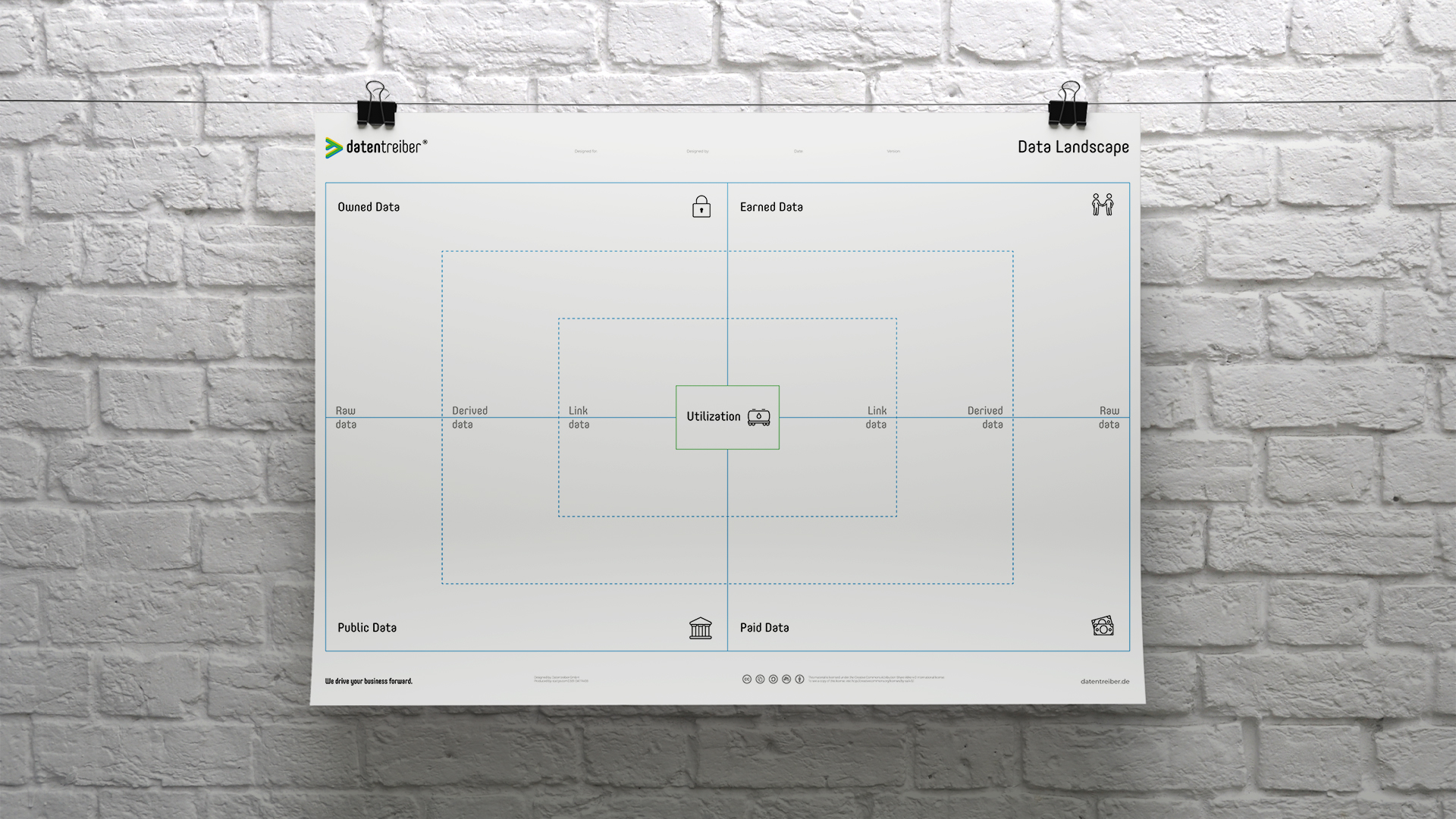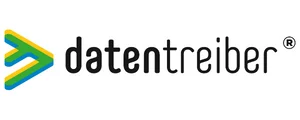
Data Landscape Canvas
By using the Data Landscape Canvas you explore new data sources and discover new data suppliers. It helps you to assess your company data and to identify the proper data sources for your utilization scenarios.
We drive your business forward.
What Is the Data Landscape Canvas?
The Data Landscape Canvas complements the Data Strategy Canvas and delves into the question of data supply by classifying data sources according to their origin:
- Owned Data: which data is available to us which have been created or recorded by us?
- Earned Data: which data do we receive from our customers and partners?
- Paid Data: which data can we buy from third parties (Third-Party-Data, Data Marketplaces) or trade in for our own data (Data Exchange)?
- Public Data: which data is publicly available (Open Data)?
Furthermore the Data Landscape Canvas differentiates between different kinds of data:
- Raw Data is data in its original form (for example measurement data).
- Derived Data has already been refined to some extend for example by cleansing or anonymizing it.
- Link Data allows to bring data from different sources in relation to each other.
The Data Landscape Canvas is available for free under a Creative Commons license: you may use and modify the canvas as long as you cite Datentreiber in particular as the source.
We drive your business forward.

We drive your business forward.
How Do I Use the Data Landscape Canvas?
A data landscape gives you an overview of the available, accessible, and required data sources of your company.
Use the data landscape to:
- Identify gaps in your data landscape and new relevant data sources.
- Conceive utilization possibilities.
- Analyze missing links between data sources or legal restrictions of data sets.
For more information, see Data Strategy Design.
Start
You can use the template in two ways:
- To explore the required and available data sources for a specific use case. Start by naming the use case and placing the appropriate card in the box utilization in the middle of the template. This can be for example a card from the box utilization of the Data Strategy template or from the template Analytics Maturity.
- To explore the data sources available to your business in general. If you want to narrow the scope, name the area of application and place a respective card in the utilization box. Otherwise, leave the box in the middle empty.
You then cycle through the four quadrants – owned ~, earned ~, paid ~ and public data – in clockwise direction and consider which data sources of the respective type are available for the specific application, necessary or at least helpful.
Areas
In addition to the four quadrants, the data landscape canvas defines three areas delimited by dashed lines, which describe the granularity and type of data (from outside to inside):
- Raw data is unprocessed and unfiltered data such as log files, measured values, (anonymized) customer surveys or transaction data.
- Derived data has already been refined, for example, by having been cleaned, normalized or aggregated. Examples are website statistics, sales figures or KPI tables.
- Link data is data used to link data from different sources to each other, for example, by connecting transaction data from an ERP system with customer data from a CRM system via a unique customer identifier.
Place your data sources in one of the three areas accordingly. If a data source contains data of different granularity or type, place the appropriate card on the boundary of either area, or create two or more cards and place them in their respective areas.
Colors
Use the following colors for the cards (data sources):
- Green: existing data sources to which you also have access.
- Yellow: data sources that are available, but to which you have no access or for example whose data quality is questionable.
- Red: data sources that are mandatory for a use case, but do not yet exist, are unknown, or where access is denied.
Step 1 of 4
Owned Data
Your most valuable data assets are typically owned data (also called “first-party data”). This is data that your company has created or collected itself and for which you have full and exclusive rights of use.
Questions:
- Which data is created by our employees (in the context of key activities)?
- Which data is collected by our technical systems (see key resources)?
- Which data do we receive through our marketing, sales, distribution and service channels (see key channels)?
- What data is collected by our (key) partners on our behalf (whereby the data collection activity is the subject of the contract rather than the data itself)?
- Which data can we capture in addition?
Examples:
- Measurement data from own devices
- Log files of IT systems
- Manual data collection by employees
- Customer surveys by an outsourced service provider
Step 2 of 4
Earned Data
Earned data is usually limited in terms of utilization and you cannot be sure that other companies, especially your competitors, will not have the same data. Earned data comes from your customers and partners (e.g. suppliers, service providers, etc.) and is collected within the context of the existing customer or supplier relationship.
If, on the other hand, the customers or partners sell the data as a standalone service or offer it explicitly in exchange for other services, this is paid data (see next section).
Questions:
- Which data do we receive through our customers (in the context of customer relationships and through our key channels)?
- Which data do our (key) partners provide us with – implicitly or explicitly?
- Which data could we ask for additionally?
Step 2 of 4
Examples:
- Customer data from a CRM system
- User data from websites, mobile apps, social media profiles, etc.
- Data from logistics or purchases through our partners
- Data we receive directly from our partners
One way to get additional customers or user data is a so-called data trap: you offer your customers or partners a free service or an app. Through this app, you then collect additional data.
Data network effects increase the willingness to provide data on users’ side: imagine a (digital) product that receives data from users and provides them with added value. The more data is available, the higher the added value and the more users use the product and in turn generate more data, the more value is added to the product.
Step 3 of 4
Paid Data
Paid data is data from other companies that you have purchased or exchanged for your own data or your own services (as part of a data exchange). If the other company has created or captured this data, it is called “second-party data”. Data brokers who sell data of other companies offer “third party data”. Another source of paid data is a data marketplace. The data providers usually do not sell the data exclusively to you and usually only for limited purposes.
If an existing customer or partner sells additional data to your business in addition to its existing business, it is paid data. Potentially, the customer or partner is both the source of earned data and a supplier of paid data.
Questions:
- With which companies have we agreed a mutual exchange of data or would it be worthwhile to conclude such a partnership?
- Which companies offer data which is helpful or necessary?
- Which relevant data do our customers, partners or competitors offer?
- Which marketplaces are available for data, that helps us?
Examples:
- Qualified addresses from data brokers
- Market research data and statistical surveys
- Anonymized user profiles from online advertisement
Step 4 of 4
Public Data
Public data is generally accessible data, for example from public internet sites, social media networks, or statistical offices. The data, at least in its raw form, is accessible to all market participants and accordingly offers little differentiation potential. However, if the data is refined, for example, it can create a unique data source. One example is Google’s PageRank algorithm which uses public data (websites) to create a prioritized search index. The search index is then owned data.
With public data, often the question of licensing is unclear: what can I do with the data if there is no explicit license agreement? To address this issue, there are Open Data: public data that is under an open-source license that governs the use, modification, and disclosure of the data. An example is Wikipedia as well as the canvas templates of Datentreiber which are under a Creative Commons license.
Step 4 of 4
Questions:
- Which authorities, universities or associations have relevant data?
- Which open data providers (open data marketplaces or open data websites) are there?
- Which data can we extract from public websites?
- Which relevant data is published on social networks?
- Which companies offer their own open data portals?
Examples:
- German GovData
- Open Data Portal of the EU
- Twitter and Facebook
- Open Data Portal of the Deutsche Bahn
Completion
Complete the work on the data landscape by following these steps:
- Check the data landscape for completeness with the following questions: “Do we have all the data available to realize the desired use case? Can we connect all data sources via suitable link data? And are there data sources that we do not yet use, but which could possibly be relevant?”
- Focus your attention on the yellow and red cards and ask yourself: “What are the open questions and critical assumptions? Who do we need to talk to, to gain access to these data sources? How can we complement missing data, for example with data partnerships with other companies or with new or enhanced products for customers? From questions like these, you can directly derive tasks and the next steps. These actions you can, for example, note down on white cards which you position next to the relevant data sources.
- Combine the data sources into databases and transfer the databases to the box utilization of the parent data strategy and/or the box key resources of a business model.
References:
- Data Strategy: the data landscape is a zoom into the box utilization of a data strategy.
- Business Model / Case: data sources are a key resource for data-driven business models. Key customers, key partners, key activities und key channels are possible data suppliers or sources of relevant data.
We drive your business forward.
Where Can I Find More Information?
The presentation referred to beside introduces you to the Data Strategy Design method and Analytics Maturity Canvas by means of an example project.
Here you can find further documentation:
Explore your Data Landscape (Blog)
With Design Thinking towards a Data-Driven Marketing (SlideShare)
Data Thinker Group (LinkedIn)
We drive your business forward.
How Can I Start?
Seminars

Get to know our Data Strategy Design Method in our practical seminars:
- For beginners: Data Strategy & Culture
- For rising stars: Data Design Thinking
- For advanced designers: Data Business Consulting
Cross References

Here you can find further canvas and information concerning Data Strategy Design:
License Terms

You are free to:
Share — copy and redistribute the canvas in any medium or format
Adapt — remix, transform, and build upon the canvas
for any purpose, even commercially.
Under the following terms:
Attribution
ShareAlike
We drive your business forward.
Subscribe to our newsletter:
Receive all relevant blog articles, new seminar dates, special conference offers and much more conveniently by email. As a welcome gift, we will send you a link to download our Datentreiber design book (in German) and, for a short time, the article ” Data Thinking: mehr Wert aus Daten” in PDF form after your registration.
By clicking ‘Subscribe to our newsletter’ you agree that we process your information in accordance with our privacy policy.


